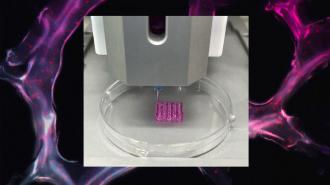A new 3D-printing-based approach could unleash a cutting-edge immunotherapy against solid tumors, which account for 90% of all cancers.
Natural killers: Some immune system cells only know to attack a threat if they’ve encountered it at least once before (or been instructed to attack it by other cells that have). Natural killer (NK) cells, however, can recognize diseased cells the first time they cross paths with them — and then alert other members of the immune system, too.
This makes them a valuable first-line defense against illness, but, unfortunately, cancer cells multiply too fast and NK cells die too quickly for them to outright stop many cancers from spreading.
The challenge: Recently, doctors have started exploring ways to take advantage of TK cells’ natural cancer-fighting abilities. Typically, this means tweaking cells in the lab (to live longer, for example), multiplying them, and then injecting them into a patient’s bloodstream.
“We expect to contribute to the treatment of cancer patients through this newly developed technology.”
Su A Park
In clinical trials, NK cell-based therapy has shown promise against blood cancers, but it hasn’t performed as well when administered to people who’ve had surgery to remove solid tumors (in an attempt to kill any remaining cancer cells that may have been missed).
Getting enough of the NK cells to reach the site of the removed tumor is one part of the problem. Helping them withstand the harsh environment around the site of the lingering tumor cells is another.
What’s new? To address these issues, researchers in South Korea developed a technique for encapsulating NK cells in a hydrogel that could be 3D printed into a porous shape and later implanted at the site of a removed tumor.
This gel was designed to develop additional, smaller holes over time, and as the NK cells were allowed to multiply in the lab, they’d be released from those “micropores” and clump together — this helped them multiply and remain viable.
In theory, the 3D-printed hydrogel would be implanted at the site of a patient’s removed tumor after the NK cells had multiplied enough. For their study, though, the researchers tested the tech on leukemia and solid tumor cells in the lab, where they did demonstrate the desired anti-cancer activity.

Looking ahead: This is just the first step in development, but the researchers are hopeful their approach could help make NK cell-based immunotherapy a more effective treatment against solid tumors.
“This technology can help to significantly improve the functionality of NK cells that are used for cancer treatment,” said principal researcher Su A Park. “We expect to contribute to the treatment of cancer patients through this newly developed technology.”
We’d love to hear from you! If you have a comment about this article or if you have a tip for a future Freethink story, please email us at [email protected].






